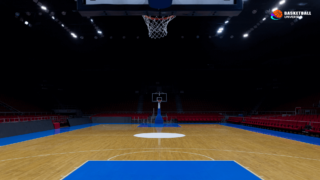
Welcome to the fascinating world of basketball strategies! Today, we’ll be diving into the intriguing 1-2-2 press break, a smart and calculated offensive maneuver designed to counteract the pressure of a full-court or half-court press. Buckle up and join us as we break down the key components of this ingenious technique, exploring how players coordinate their efforts to outsmart the opposing team and confidently advance into the offensive court. Whether you’re a coach, a curious player or a genuine aficionado of the game, this blog post will enlighten you with insights into one of basketball‘s most effective press break strategies. So, let’s get started!
What’s a 1-2-2 Press Break in Basketball?
A 1-2-2 press break in basketball is an offensive strategy used to counter a full-court or half-court press. It involves positioning one player at the point guard position (1), two players between the free-throw line and mid-court (2), and two more players below the free-throw line extended (2). The objective is to swiftly and accurately pass the ball, create spacing, and beat the press by advancing the ball up the court, ultimately allowing the offense to set up a scoring opportunity.
Understanding the Press in Basketball
Before we dive into the 1-2-2 press break, it’s crucial to understand the press in basketball. The press is an aggressive defensive tactic employed to disrupt the flow of the offense, challenge ball handlers, and force bad decisions or turnovers. These strategies may focus on full-court pressure (extending across the entire court) or half-court pressure (employed around the mid-court line). Generally, the press aims to control the tempo of the game and keep the offense off balance.
Breaking Down the 1-2-2 Press Break Formation
The first step to master the 1-2-2 press break is understanding player positioning:
- 1 (Point Guard): Positioned near the baseline, responsible for initiating the press break by receiving the inbound pass and connecting with the other players up the court.
- 2 (Wings): Positioned around the free-throw line extended or slightly above, these players offer passing support to the 1 and help advance the ball up the court.
- 3 (Middle): Positioned between the wings, around the mid-court area, this player acts as an essential safety valve to safely transfer the basketball past half-court.
- 4 and 5 (Posts): Positioned beneath the free-throw line, they create a high-low formation, giving the offense additional passing options and threatening the defense down low.
Key Principles of the 1-2-2 Press Break
To run a successful 1-2-2 press break, players must understand and execute several key principles:
Maintaining Ball Security
Ball security is paramount when facing a press defense. Players should avoid over-dribbling and prioritize quick, accurate passes to advance the ball up the court. Crisp, sharp ball movement is crucial to avoid turnovers and beat the press.
Effective Spacing and Movement
Well-executed spacing can cause the press to collapse, helping the offensive players find open lanes and opportunities. Each player should maintain a proper distance from their teammates, keeping options open for swift ball movement to beat the press.
Communication and Timing
Being vocal and maintaining awareness of teammates’ positions are critical components of a successful 1-2-2 press break. Players should communicate both vocally and through body language, calling for the ball when open or redirecting when covered.
Executing the 1-2-2 Press Break Step by Step
Now that we’ve covered the basics, let’s delve into the step-by-step process of executing a 1-2-2 press break:
Step 1: Inbound the Ball to the Point Guard (1)
The play begins with a pass from the inbounder to the point guard (1). This player should ideally have excellent ball-handling skills and court vision, as they are responsible for initiating the press break and connecting with the other players up the court.
Step 2: Advance the Ball with the Wings (2)
The point guard (1) looks to pass to one of the wings (2) to advance the ball upcourt. These wing players should work to get open using sharp cuts and screens. Upon getting the ball, the wing players should quickly scan the court for progression options, either through dribbling or passing to the next receiver.
Step 3: Utilize the Middle (3) or Posts (4, 5) When Needed
If there is pressure on the wings (2) or they cannot advance the ball, look for the middle player (3) around the mid-court area, offering a safe passing option. The post players (4 and 5) can especially be valuable targets if the defense is overly-extended, opening up opportunities for a high-low action down low.
Step 4: Cross the Half-Court Line
As the offense works its way across the half-court line, players should remain vigilant about maintaining spacing and ball security. The goal is to advance the ball while alleviating the pressure that the defense is applying.
Step 5: Transition into Half-Court Offense
Once the 1-2-2 press break has defeated the press, it’s essential for the offensive players to transition into their half-court offensive set. This involves spreading the floor, looking for open teammates, and creating scoring opportunities.
Common Mistakes and How to Avoid Them
During a 1-2-2 press break, there are a few common mistakes that can hinder its effectiveness. Here’s how to avoid them:
Mistake 1: Over-dribbling the Basketball
When facing a press, over-dribbling can lead to turnovers and bad decisions. Encourage players to pass rather than dribble and utilize the safe options provided by the press break formation.
Mistake 2: Poor Court Awareness
Players should be aware of the location of their teammates, the defensive positioning, and the half-court line. Improving court awareness can lead to better, safer decisions and increased success in breaking the press.
Mistake 3: Predictable Ball Movement
If the offense becomes predictable, it’s easier for the defense to anticipate and intercept passes. Encourage players to make sharp cuts and use a change of pace to keep the defense off balance.
Adapting the 1-2-2 Press Break for Different Levels of Play
The 1-2-2 press break can be adjusted to fit different levels of play, providing flexibility for coaches and players:
Jr. High and High School
At the Jr. High and High School levels, the opponents’ press may not be as aggressive or as well-coordinated, allowing for a greater focus on fundamental skills such as passing, ball-handling, and court awareness.
College and Professional
At the College and Professional levels, the press break would require more precision and speed, even incorporating advanced techniques such as misdirection, no-look passes, and euro steps to overcome the increased skill and understanding of the press defenses.
In conclusion, the 1-2-2 press break offers a well-coordinated strategy to defeat pressing defenses in basketball. By understanding the formation, key principles, and specific steps involved, players can work together to break down the press, maintain control of the game, and create scoring opportunities.
Drills to Improve Your 1-2-2 Press Break
To effectively execute the 1-2-2 press break strategy, players should be equipped with the right skills through practice and training. Here are a few essential drills that can help improve your ability to break the press:
Three-Line Passing Drill
Developing accurate and quick passing is crucial to a successful 1-2-2 press break. In the three-line passing drill, players are divided into three lines along the baseline. The first player in each line passes the ball to the middle player and sprints to the mid-court. The middle player passes to the farthest player and follows with a sprint to the farthest sideline. This drill helps improve passing accuracy while maintaining proper spacing and communication.
Two-on-One Fast Break Drill
This drill helps develop decision-making and ball handling skills while creating a transition scoring opportunity. Two offensive players work on the fast break against a single defender. The aim is to force the defender to commit to one player, leaving the other player open for a pass and a scoring opportunity. This drill simulates the moments when the press break effectively beats the press, and the offense is transitioning into their half-court game.
Four-Corners Drill
This drill helps players work on ball handling, court spacing, and communication in a confined space. Players are positioned in the four corners of the half-court or a smaller square, with a designated player in the middle. The middle player passes to one of the corner players and rotates to that corner. The drill continues with all players moving clockwise or counter-clockwise. The primary objective is to maintain proper spacing while strengthening passing and communication skills.
Defensive Strategies to Counter the 1-2-2 Press Break
As a defensive team, countering the 1-2-2 press break can be challenging, but it’s achievable with the right approach. Here are a few defensive strategies to consider:
Disrupt the Inbound Pass
By putting pressure on the inbounder, the defense can disrupt the initial pass to the point guard (1). This can be achieved by using taller or more athletic defenders to contest the pass or obscure the inbounder’s vision.
Double-Teaming the Ball Handler
Forcing the ball out of the hands of the primary ball handler can disrupt the flow of the press break. The defense can momentarily double-team the point guard (1) or wing players (2) in strategic locations to force turnovers or bad decisions.
Anticipating Passes and Switching
Defensive players should stay alert and ready to jump passing lanes or switch on screens to put additional pressure on the passing options. This strategy can lead to deflections, steals, and disrupted offensive flow.
By incorporating these drills and strategies, players and teams can enhance their 1-2-2 press break execution, equipping themselves to defeat various press defenses. Alongside consistent practice and continuous learning, teams can efficiently employ the 1-2-2 press break, overcoming defensive pressure and maintaining control of the game.
FAQ: Frequently Asked Questions About the 1-2-2 Press Break
In case you still have some queries regarding the 1-2-2 press break, we’ve compiled a list of frequently asked questions with concise answers to help you gain a better understanding of this strategic maneuver in basketball.
1. What is the primary objective of a press break in basketball?
The primary objective of a press break is to defeat a full-court or half-court press while maintaining ball possession, thus allowing the offense to advance up the court and set up a scoring opportunity.
2. Can the 1-2-2 press break be used against different types of presses?
Yes, the 1-2-2 press break can be employed to counter various types of presses, including full-court man-to-man, full-court zone, and half-court traps, due to its flexibility and adaptability.
3. What skills are essential for players to execute the 1-2-2 press break effectively?
For effective 1-2-2 press break execution, players should possess strong passing and ball-handling skills, court awareness, communication abilities, and the capacity to maintain proper spacing.
4. Can the 1-2-2 press break work in high-pressure situations?
Yes, the 1-2-2 press break can be effective in high-pressure situations, given that players remain composed, communicate effectively, and maintain ball security while executing the strategy.
5. How do the wing players contribute to the success of the 1-2-2 press break?
Wing players serve as primary receivers and contributors for advancing the ball upcourt. They help create spacing, provide passing support to the point guard, and connect with other teammates as the press break progresses.
6. How can the middle player assist if wings are facing pressure in a 1-2-2 press break?
If wings face pressure, the middle player, positioned near the mid-court area, can act as a safety valve, allowing ball handlers to reset and maintain possession while safely transferring the basketball past half-court.
7. How important is communication during the 1-2-2 press break?
Communication plays a vital role during the 1-2-2 press break, as it assists players in quickly reading and responding to on-court situations, particularly when facing aggressive or dynamic press defenses.
8. Is the 1-2-2 press break suitable for teams with limited height?
Yes, the 1-2-2 press break can be adapted to accommodate teams with limited height, particularly by focusing on quick ball movement, maintaining optimal spacing, and utilizing smaller players’ speed and agility to exploit defensive gaps.
9. How can a team practice the 1-2-2 press break efficiently?
Coaches can incorporate specific drills, such as three-line passing, two-on-one fast break, and four-corners drills, to practice various aspects of the 1-2-2 press break, including passing, ball handling, court awareness, and communication.
10. How can a defense counter the 1-2-2 press break effectively?
To counter the 1-2-2 press break, the defense can adopt strategies like disrupting the inbound pass, double-teaming the ball handler, and anticipating passes by closely monitoring the opposition’s movement and communication patterns.
Featured Posts
- No pillar pages found.





